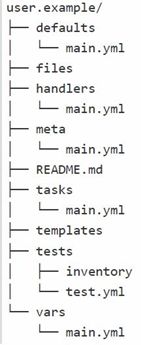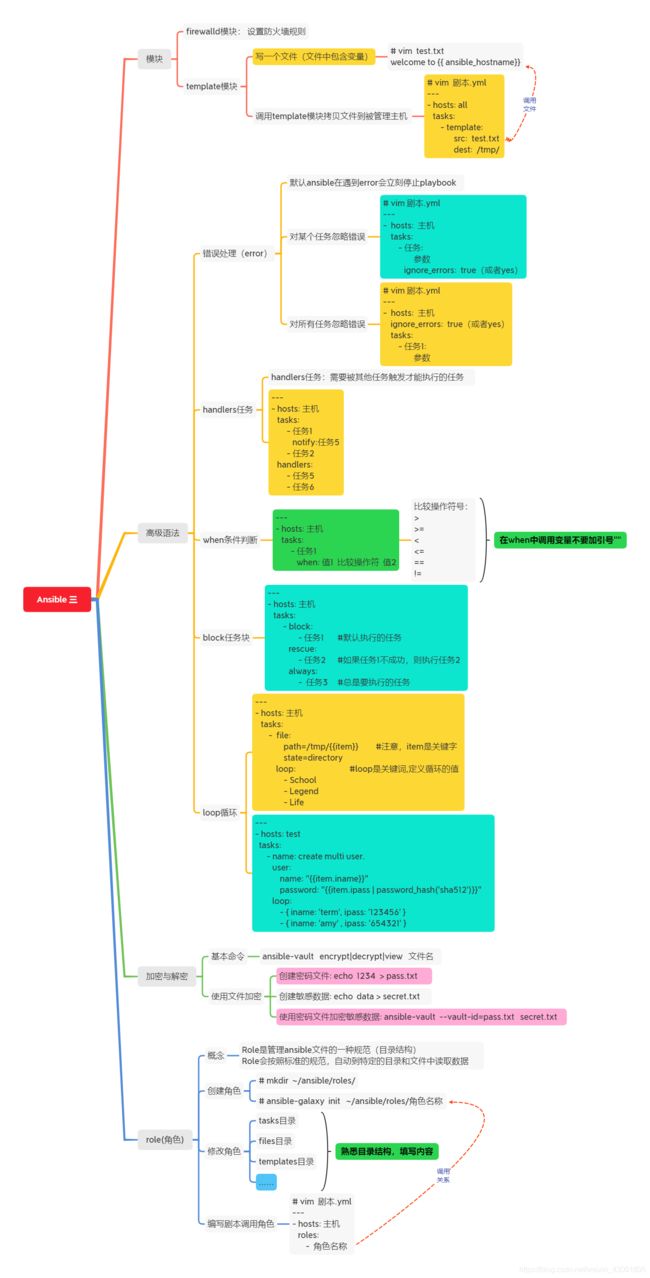linux之AUTOMATION(自动化运维)三
linux之AUTOMATION(自动化运维)
01: ansible基础 、 Ansible ad-hoc02: sudo提权 、 Ansible配置 、 Ansible Playbook 、 Ansible进阶
03: Ansible进阶 、 Ansible Vault 、 Ansible Roles 、 综合练习
文章目录
- linux之AUTOMATION(自动化运维)
- Ansible进阶 、 Ansible Vault 、 Ansible Roles 、 综合练习
- ansible应用案例
-
- 问题
- 步骤
-
- 一:firewalld模块
- 二:template模块
- 三:Ansible高级语法应用
- 实例草稿:
- 加密敏感数据
-
- 问题
- 步骤
-
- 一:使用ansible-vault处理敏感数据
- Ansible Roles
-
- 问题
- 方案
-
- 一:Role应用案例
- 二:ansible-galaxy命令
- 综合练习(自动化部署Web集群)
-
- 问题
- 方案
-
- 一:部署两台后端web服务器
- 二:部署nginx代理服务器
- 重要的事情说三遍
Ansible进阶 、 Ansible Vault 、 Ansible Roles 、 综合练习
ansible应用案例
问题
本案例要求掌握Ansible更多高级语法知识,具体要求如下:
熟悉firewalld和template模块的使用 熟悉error处理机制 熟悉handlers任务 熟悉when条件判断
熟悉block任务块 熟悉loop循环的使用方法
步骤
实现此案例需要按照如下步骤进行。
一:firewalld模块
使用firewalld模块可以配置防火墙策略。
[root@control ~]# vim ~/ansible/firewall.yml
---
- hosts: test #hosts定义需要远程的主机
tasks: #tasks定义需要执行哪些任务
- name: install firewalld. #name为第一个任务定义描述信息
yum: #第一个任务调用yum模块安装软件
name: firewalld #需要安装的软件名称为firewalld
state: present #state等于present代表安装软件
- name: run firewalld. #定义第二个任务的描述信息
service: #第二个任务调用service模块启动服务
name: firewalld #启动的服务名称为firewalld
state: started #state等于started代表启动服务
enabled: yes #enabled等于yes是设置服务为开机自启动
- name: set firewalld rule. #第三个任务的描述信息
firewalld: #第三个任务调用firewalld模块设置防火墙规则
port: 80/tcp #在防火墙规则中添加一个放行tcp,80端口的规则
permanent: yes #permaenent 是设置永久规则
immediate: yes #immediate 是让规则立刻生效
state: enabled #state等于enabled是添加防火墙规则
#最终:在默认zone中添加一条放行80端口的规则
二:template模块
copy模块可以将一个文件拷贝给远程主机,但是如果希望每个拷贝的文件内容都不一样呢?如何给所有web主机拷贝index.html内容是各自的IP地址?
Ansible可以利用Jinja2模板引擎读取变量,之前在playbook中调用变量,也是Jinja2的功能,Jinja2模块的表达式包含在分隔符"{{
}}"内。这里,我们给webserver主机拷贝首页,要求每个主机内容不同。
[root@control ansible]# mkdir ~/ansible/template
[root@control ansible]# vim ~/ansible/template/index.html
Welcome to {{ansible_hostname}} on {{ ansible_eth0.ipv4.address }}.
#注意网卡名称根据实际情况填写,不可以完全照抄,不知道网卡名可以通过ip a s查询!
#{{ansible_hostname}}和{{ ansible_eth0.ipv4.address }}是ansible自动的facts变量。
2)编写Playbook将网页模板文件拷贝到远程主机。
[root@control ansible]# vim ~/ansible/template.yml
---
- hosts: webserver
tasks:
- name: use template copy index.html to webserver.
template:
src: ~/ansible/template/index.html
dest: /tmp/index.html
#hosts定义需要远程的目标主机是谁;tasks定义需要执行的任务是什么
#- name定义任务的描述信息;任务需要调用的模块是template模块
#template模块需要两个参数,src指定需要拷贝的源文件,dest指定需要拷贝的目标位置
#src: ~/ansible/template/index.html是上面创建的文件,文件中包含变量
#dest: /tmp/index.html拷贝到目标主机放在/tmp目录下
三:Ansible高级语法应用
1)error错误处理
默认ansible在遇到error会立刻停止playbook,使用ignore_errors可以忽略错误,继续后续的任务。
如果一个剧本里面有20个任务,执行到第3个时失败,则不再往下执行。
下面这个这个Playbook在执行时会意外中断。
[root@control ansible]# vim ~/ansible/error.yml
---
- hosts: test
tasks:
- name: start a service that does not exist.
service:
name: hehe #注意:没有这个服务(启动一个不存在的服务)
state: started
- name: touch a file.
file:
path: /tmp/service.txt
state: touch
下面这个Playbook在执行时因为忽略了错误(针对某一个任务),不会被中断。
[root@control ansible]# vim ~/ansible/error.yml
---
- hosts: test
tasks:
- name: start a service that does not exist.
service:
name: hehe
state: started
ignore_errors: true #针对某一个任务忽略错误(ignore_errors是关键词)
- name: touch a file.
file:
path: /tmp/service.txt
state: touch
下面这个Playbook在执行时因为忽略了错误,不会被中断。
[root@control ansible]# cat ~/ansible/error.yml
---
- hosts: test
ignore_errors: true #针对playbook全局忽略错误
tasks:
- name: start a service that does not exist.
service:
name: hehe
state: started
- name: touch a file.
file:
path: /tmp/service.txt
state: touch
2)handlers
在剧本中tasks用来定义任务(一定会执行),handlers也可以定义任务(不一定执行),handlers任务要想执行必须要被别人触发才能执行。
实例草稿:
- hosts: test
tasks:
- 任务1
notify:任务5
- 任务2
handlers:
- 任务5
- 任务6
可以通过handlers定义一组任务,仅当某个任务触发(notify)handlers时才执行相应的任务,如果有多个notify触发执行handlers任务,也仅执行一次。
仅当任务的执行状态为changed时handlers任务才执行,handlers任务在所有其他任务都执行后才执行。
下面编写一个通过notify触发执行handlers任务的案例。
[root@control ansible]# vim ~/ansible/handlers.yml
---
- hosts: test
tasks:
- name: create directory. #多次执行playbook该任务状态不再是changed
file: #调用file模块创建目录
path: /tmp/parents/subdir/ #需要创建的具体目录名称
state: directory #state等于directory代表创建目录
notify: touch file #notify后面名称必须和handlers中的任务名称一致
handlers: #通过handlers再定义一组任务
- name: touch file #给任务写描述信息(任务的名字,名字可以任意)
file: #调用file模块创建文件
path: /tmp/parents/subdir/new.txt #需要创建的文件名
state: touch #state等于touch代表创建文件
#备注:仅当file模块执行成功,
#并且状态为changed时才会通过notify触发执行handlers下面的任务,
#所以多次执行该剧本时,handlers任务不会被重复执行,
#notity后面的名称必须和handlers下面name定义的任务名称一致(名称可以任意)。
3)when条件判断
when可以定义判断条件,条件为真时才执行某个任务。
常见条件操作符有:==、!=、>、>=、<、<=。
多个条件可以使用and(并且)或or(或者)分割,when表达式中调用变量不要使用{{ }}。
下面编写Playbook,远程主机剩余内存不足700M则关闭NetworkManager服务
[root@control ansible]# vim ~/ansible/when_1.yml
---
- hosts: test
tasks:
- name: check memory size.
service:
name: NetworkManager
state: stopped
when: ansible_memfree_mb < 700
#被管理端主机剩余内存不足700M则关闭NetworkManager服务(也可以关闭别的不需要的服务)
#ansible_memfree_mb这个是ansible自带的facts变量,代表剩余内存的容量。
下面再编写一个Playbook,判断操作系统是RedHat8则创建测试文件。YAML的语法格式中>支持多行输入,但不保留换行符。
[root@control ansible]# vim ~/ansible/when_2.yml
---
- hosts: test
tasks:
- name: touch a file
file:
path: /tmp/when.txt
state: touch
when: >
ansible_distribution == "RedHat"
and
ansible_distribution_major_version == "8"
#判断操作系统是RedHat8则创建测试文件
#YAML的语法格式中>支持多行输入,但不保留换行符(计算机会认为实际是一行内容)
#ansible_distribution和ansible_distribution_major_version都是自带的facts变量
#可以使用setup模块查看这些变量
4)block任务块
如果我们需要当条件满足时执行N个任务,我们可以给N个任务后面都加when判断(但是很麻烦),此时可以使用block定义一个任务块,当条件满足时执行整个任务块.
任务块就是把一组任务合并为一个任务组,使用block语句可以将多个任务合并为一个任务组。
[root@control ansible]# vim ~/ansible/block_1.yml
---
- hosts: test
tasks:
- name: define a group of tasks.
block: #block是关键词,定义任务组
- name: install httpd #任务组中的第一个任务
yum: #调用yum模块安装httpd软件包
name: httpd
state: present
- name: start httpd #任务组中的第二个任务
service: #调用service模块启动httpd服务
name: httpd
state: started
when: ansible_distribution == "RedHat" #仅当条件满足再执行任务组
#注意:when和block是对齐的,他们在一个级别,当条件满足时要执行的是任务组(不是某一个任务)
#判断条件是看远程的目标主机使用的Linux发行版本是否是RedHat.
对于block任务块,我们可以使用rescue语句定义在block任务执行失败时要执行的其他任务,还可以使用always语句定义无论block任务是否成功,都要执行的任务。
下面编写一个包含rescue和always的示例。
[root@control ansible]# vim ~/ansible/block_2.yml
---
- hosts: test
tasks:
- block:
- name: touch a file test1.txt
file:
name: /tmp/test1.txt #如果修改为/tmp/xyz/test1.txt就无法创建成功
state: touch
rescue:
- name: touch a file test2.txt
file:
name: /tmp/test2.txt
state: touch
always:
- name: touch a file test3.txt
file:
name: /tmp/test3.txt
state: touch
#默认在/tmp/目录下创建test1.txt会成功,所以不执行rescue(创建test2.txt)
#如果我们把block中的任务改为创建/tmp/xyz/test1.txt(因为没有xyz目录所以会失败)
#当block默认任务失败时就执行rescue任务(创建test2.txt)
#但是不管block任务是否成功都会执行always任务(创建test3.txt)
5)loop循环
相同模块需要反复被执行怎么处理?使用loop循环可以避免重复。
编写Playbook,循环创建目录。
[root@control ansible]# vim ~/ansible/simple_loop.yml
---
- hosts: test
tasks:
- name: mkdir multi directory.
file:
path=/tmp/{{item}} #注意,item是关键字,调用loop循环的值
state=directory
loop: #loop是关键词,定义循环的值,下面是具体的值
- School
- Legend
- Life
#最终在/tmp目录下创建三个子目录.file模块被反复执行了三次。
#mkdir /tmp/School; mkdir /tmp/Legend; mkdir /tmp/Life。
编写Playbook,循环创建用户并设置密码。
[root@control ansible]# vim ~/ansible/complex_loop.yml
---
- hosts: test
tasks:
- name: create multi user.
user:
name: "{{item.iname}}"
password: "{{item.ipass | password_hash('sha512')}}"
loop:
- { iname: 'term', ipass: '123456' }
- { iname: 'amy' , ipass: '654321' }
#loop循环第一次调用user模块创建用户,user模块创建用户会读取loop里面的第一个值.
#loop第一个值里面有两个子值,iname和ipass
#创建用户item.iname就是loop第一个值里面的iname=term
#修改密码item.ipass就是loop第一个值里面的ipass=123456
#loop循环第二次调用user模块创建用户,user模块创建用户会读取loop里面的第二个值.
#loop第二个值里面有两个子值,iname和ipass
#创建用户item.iname就是loop第二个值里面的iname=amy
#修改密码item.ipass就是loop第二个值里面的ipass=654321
加密敏感数据
问题
本案例要求,使用ansible-vault对敏感数据进行加密处理,具体要求如下:
使用ansible-vault管理敏感数据
步骤
实现此案例需要按照如下步骤进行。
一:使用ansible-vault处理敏感数据
1)加密敏感数据。
encrypt(加密)、decrypt(解密)、view(查看)。
[root@control ansible]# echo 123456 > data.txt #新建测试文件
[root@control ansible]# ansible-vault encrypt data.txt #加密文件
[root@control ansible]# cat data.txt
[root@control ansible]# ansible-vault view data.txt #查看加密文件
2)修改密码(rekey)
[root@control ansible]# ansible-vault rekey data.txt #修改密码
Vault password: <旧密码>
New Vault password: <新密码>
Confirm New Vault password:<确认新密码>
3)解密文件
[root@control ansible]# ansible-vault decrypt data.txt #解密文件
[root@control ansible]# cat data.txt
4)使用密码文件
加密、解密每次都输入密码很麻烦,可以将密码写入文件。
[root@control ansible]# echo "I'm secret data" > data.txt #需要加密的敏感数据
[root@control ansible]# echo 123456 > pass.txt #加密的密码
[root@control ansible]# ansible-vault encrypt --vault-id=pass.txt data.txt
[root@control ansible]# cat data.txt
[root@control ansible]# ansible-vault decrypt --vault-id=pass.txt data.txt
[root@control ansible]# cat data.txt
Ansible Roles
问题
学习Ansible Roles基本概念,掌握Roles应用案例,具体要求如下:
自定义Ansible Role 编写playbook调用role 使用ansible-galaxy管理Roles
方案
在实际生产环境中,为了实现不同的功能,我们会编写大量的playbook文件。而且,每个playbook还可能会调用其他文件(如变量文件),对于海量的、无规律的文件,管理起来非常痛苦!
Ansible从1.2版本开始支持Role(角色),Role(角色)是管理ansible文件的一种规范(目录结构),Role(角色)会按照标准的规范,自动到特定的目录和文件中读取数据。
如果我们创建了一个名称为user.example的Role(角色),则其标准的目录结构如下图-1所示。
图-1
Roles目录结构中主要文件的作用是什么呢?
defualts/main.yml:定义变量的缺省值,优先级较低 files目录:存储静态文件的目录,如tar包、音乐、视频等
handlers/main.yml:定义handlers meta/main.yml:写作者、版本等描述信息
README.md:整个角色(role)的描述信息 tasks/main.yml:定义任务的地方
templates目录:存放动态数据文件的地方(文件中包含了变量的模板文件) vars/main.yml:定义变量,优先级高
一:Role应用案例
1)创建Roles
下面这个案例目的:编写一个包含变量的模板文件,编写任务调用template模块,将模板文件拷贝给被管理端主机。
ansible-galaxy命令可以创建、管理自己的roles。
[root@control ansible]# mkdir ~/ansible/roles
[root@control ansible]# ansible-galaxy init ~/ansible/roles/issue
#创建一个Role,该Role的目的是拷贝自己新建的一个模板文件到远程主机的/etc/issue
[root@control ansible]# tree ~/ansible/roles/issue/
#查看目录结构,如果没有tree命令则需要使用yum安装该软件
2)修改Role文件
定义名称为myfile.txt的模板文件(该文件包含变量,因此必须放置templates目录)
[root@control ansible]# vim ~/ansible/roles/issue/templates/myfile.txt
This is the system {{ansible_hostname}}
Today's date is:{{ansible_date_time.date}}
Contact to {{ admin }}
自定义变量文件(前面调用了admin这个变量,这里需要定义admin变量并赋值)
[root@control ansible]# vim ~/ansible/roles/issue/vars/main.yml
---
# vars file for /root/ansible/roles/issue
admin: [email protected]
#变量名为admin,变量的值为[email protected]
文件准备好了,计算机不会自动将文件拷贝给被管理端主机!需要编写任务调用模块实现拷贝的功能。
修改任务文件,任务文件中不需要tasks关键词,Role的各个文件之间相互调用不需要写文件的路径。
[root@control ansible]# vim ~/ansible/roles/issue/tasks/main.yml
---
# tasks file for /root/ansible/roles/issue
- name: delever issue file
template:
src: myfile.txt
dest: /etc/issue
#调用template模块将myfile.txt文件拷贝给被管理端主机.
3)在Playbook中调用Role
Role创建好了,role不会自己运行,需要编写一个剧本调用上面的role。
编写playbook剧本文件,通过roles关键词调用role。
[root@control ansible]# vim ~/ansible/issue.yml
---
- hosts: test
roles:
- issue
# - role2 #支持加载多个role
修改ansible.cfg配置文件,定义roles目录。
[root@control ansible]# vim ~/ansible/ansible.cfg
[defaults]
inventory = ./inventory
roles_path = ./roles #指定到哪个目录下找role
remote_user = alice
[privilege_escalation]
become=True
become_method=sudo
become_user=root
become_ask_pass=False
二:ansible-galaxy命令
公共Roles仓库(https://galaxy.ansible.com)管理。
[root@control ansible]# ansible-galaxy search 'httpd'
#联网搜索roles
[root@control ansible]# ansible-galaxy info acandid.httpd
#查看roles基本信息
[root@control ansible]# ansible-galaxy install acandid.httpd -p ~/ansible/roles/
#下载roles到特定的目录,-p可以指定下载到哪个目录
使用ansible-galaxy install可以直接下载Role,也可以编写requirements.yml文件下载Role。
[root@control ansible]# vim ~/ansible/roles/requirements.yml
#格式一:可以直接从Ansible Galaxy官网下载
- src: acandid.httpd
#格式二:可以从某个git服务器下载
- src: http://gitlab.com/xxx/xxx.git
scm: git
version: 56e00a54
name: nginx-acme
#格式三:可以指定位置下载tar包,支持http、https、file
- src: http://example.com/myrole.tar
name: myrole
[root@control ansible]# ansible-galaxy install \
-r ~/ansible/roles/requirements.yml \
-p roles
# -r后面跟文件名,该文件中包含了需要下载哪些role以及他们的链接位置
# -p 指定将下载的role保存到哪个目录
综合练习(自动化部署Web集群)
问题
晚自习课外综合练习题,创建一个名为cluster的role,完成一个综合项目,具体要求如下:
创建Role,通过Role完成项目 部署Nginx调度器 部署2台http服务器
方案
晚自习综合练习题实验所需主机清单如表-1所示。
一:部署两台后端web服务器
1)创建role角色
[root@control ansible]# ansible-galaxy init ~/ansible/roles/http
2)修改role配置文件,准备2台http网站的素材
安装httpd,拷贝一个网页文件。
[root@control ansible]# vim roles/http/tasks/main.yml
---
- name: install httpd
yum:
name: httpd
state: present
- name: create index.html
copy:
content: "{{ansible_hostname}}"
dest: /var/www/html/index.html
- name: set firewalld
firewalld:
service: http
state: enabled
permanent: yes
immediate: yes
- name: start httpd
service:
name: httpd
state: started
enabled: yes
#文件中包含多个任务,每个任务可以设置一个name名字(也可以没有name)
#第一个任务调用yum模块安装httpd软件包
#第二个任务调用copy模块创建一个新的网页文件(index.html)
#调用copy模块时可以在没有源文件的情况下,直接使用content指定文件的内容
#将该内容直接拷贝到被管理主机的某个文件中(/var/www/html/index.html)
#第三个任务调用firewalld模块,设置防火墙规则,允许访问http服务
#第四个任务调用service模块将httpd服务启动,并设置开机自启。
3)编写Playbook调用role,并执行Playbook。
[root@control ansible]# vim web.yml
---
- hosts: webserver
roles:
- http
[root@control ansible]# ansible-playbook web.yml
二:部署nginx代理服务器
1)创建role角色
[root@control ansible]# ansible-galaxy init ~/ansible/roles/proxy
2)准备代理服务器需要的素材
拷贝Nginx源码包,编写一个源码编译安装nginx的shell脚本。
[root@control ansible]# cp lnmp_soft/nginx-1.17.6.tar.gz \
~/ansible/roles/proxy/files/
[root@control ansible]# vim ~/ansible/roles/proxy/files/nginx_install.sh
#!/bin/bash
yum -y install gcc pcre-devel openssl-devel make
cd /tmp
tar -xf /tmp/nginx-1.17.6.tar.gz
cd nginx-1.17.6
./configure --with-http_ssl_module
make
make install
新建一个Nginx代理服务器的配置文件模板。
[root@control ansible]# vim ~/ansible/roles/proxy/files/nginx.conf
worker_processes 2;
#error_log logs/error.log;
events {
worker_connections 65535;
}
http {
include mime.types;
default_type application/octet-stream;
sendfile on;
tcp_nopush on;
keepalive_timeout 65;
#gzip on;
upstream webs {
server 192.168.4.13;
server 192.168.4.14;
}
server {
listen 80;
server_name localhost;
location / {
proxy_pass http://webs;
root html;
index index.html index.htm;
}
error_page 404 /404.html;
error_page 500 502 503 504 /50x.html;
location = /50x.html {
root html;
}
}
}
3)修改role配置文件。
[root@control ansible]# vim roles/proxy/tasks/main.yml
---
- name: copy nginx-1.17.6.tar.gz to proxy.
copy:
src: nginx-1.17.6.tar.gz
dest: /tmp/
#拷贝源码包软件
- name: install nginx through shell script.
script: nginx_install.sh
args:
creates: /usr/local/nginx/sbin/nginx
#执行源码编译安装脚本,如果已经安装nginx,则不再执行安装脚本.
#args是关键词,设置script模块的参数,通过creates参数做判断,creates也是关键词
#creates后面跟文件名,如果creates判断文件存在的话就不再执行script模块对应的命令。
- name: copy nginx.conf to destination host.
copy:
src: nginx.conf
dest: /usr/local/nginx/conf/nginx.conf
- name: run nginx service.
shell: /usr/local/nginx/sbin/nginx
args:
creates: /usr/local/nginx/logs/nginx.pid
#nginx.pid存在,说明nginx已经启动。如果该文件存在,则不再启动nginx。
4)编写Playbook调用role,并执行Playbook。
[root@control ansible]# vim proxy.yml
---
- hosts: proxy
roles:
- proxy
[root@control ansible]# ansible-playbook proxy.yml
附加思维导图,如图-2所示:
图-2
重要的事情说三遍
作为一个为linux奉献一生的码员,很是荣幸和骄傲,这里我总结了一些linux的精华,也就是速成文章,后面还会继续更新,望大家关注,绝对有用!


